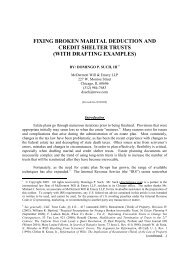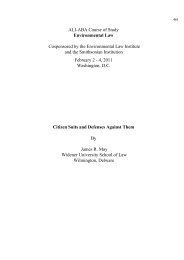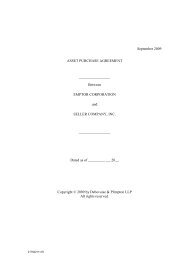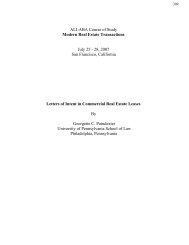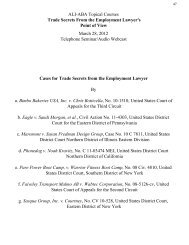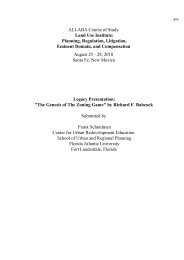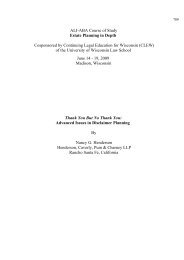ALI-ABA Topical Courses Trademark Law: What's New ... - ALI CLE
ALI-ABA Topical Courses Trademark Law: What's New ... - ALI CLE
ALI-ABA Topical Courses Trademark Law: What's New ... - ALI CLE
Create successful ePaper yourself
Turn your PDF publications into a flip-book with our unique Google optimized e-Paper software.
6Wolfson, are the transformative test, urged in his papers by Hart, and the Rogers test,advocated by EA, and it is here that the decision makes its greatest contribution to this areaof the law. Although expressing a preference for the transformative test because “it bestencapsulates the type of nuanced analysis required to properly balance the competing . . .interest[s],” the Court found that EA prevailed under either test.The Court explained that the transformative test, which has its origins in the fair use analysisof copyright law and has been applied in a number of jurisdictions, looks to the extent thatthe likeness has been transformed by expressive changes or additions in the new work, or, inthe words of the California Supreme Court, whether “the celebrity likeness is one of the ‘rawmaterials’ from which an original work is synthesized, or whether the depiction of thecelebrity is the very sum and substance of the work in question." 2 Reviewing recent casesapplying the transformative test, including to videogames, the Court concluded that EA’s useof plaintiff’s likeness was transformative. 3 Although the game structure begins with an avatarthat incorporates many elements of Hart’s likeness and that of other college players, EAdesigners added many interactive expressive features that create a new work out of thatlikeness, including virtual stadiums, coaches, fans, sound effects, music and commentary.Key to the Court’s decision was that the game permits users to alter many of the players’physical characteristics and skills, change the composition of teams, and determine theoutcome of individual games and the entire season in a multitude of different ways. Thisinteractive element is what distinguishes NCAA Football from the works at issue in othercases that have failed the transformative test.The Court went out of its way to address the contrary holding in Keller v. Electronic Arts, Inc. 4a putative class action involving the same series of video games. There, denying EA’s motionto dismiss under California’s anti-SLAPP statute, the district court for the Northern Districtof California held that NCAA Football was not sufficiently transformative. Noting that thepresent motion for summary judgment embraced a broader factual record, Judge Wolfsoncriticized the Keller court’s failure to take into account the expressive nature of the interactivefeatures of the game and its overly narrow focus on the alleged likeness alone instead of thegame as a whole. “[I]n my view, it is logically inconsistent to consider the setting in whichthe character sits, which Keller does in its analysis, yet ignore the remainder of the game.”The Rogers test, developed by the Second Circuit in Rogers v. Grimaldi, was derived fromprotections against false endorsement under the Lanham Act, and has been applied to anumber of right of publicity claims in that and other circuits. In essence, the test askswhether the challenged work is wholly unrelated to the underlying work or whether the useof the plaintiff’s name or likeness is a disguised commercial advertisement. Although JudgeWolfson praised the clarity of its application, she questioned whether a test derived fromtrademark law was properly applicable to a right of publicity claim and whether it struck theright balance between the competing interests. Nonetheless, applying the test to the facts atissue, Hart’s image was clearly not wholly unrelated to NCAA Football, nor was itsincorporation into the game a “disguised commercial advertisement” indicating hisendorsement or creative input. Summary judgment was therefore appropriate under this testas well.




